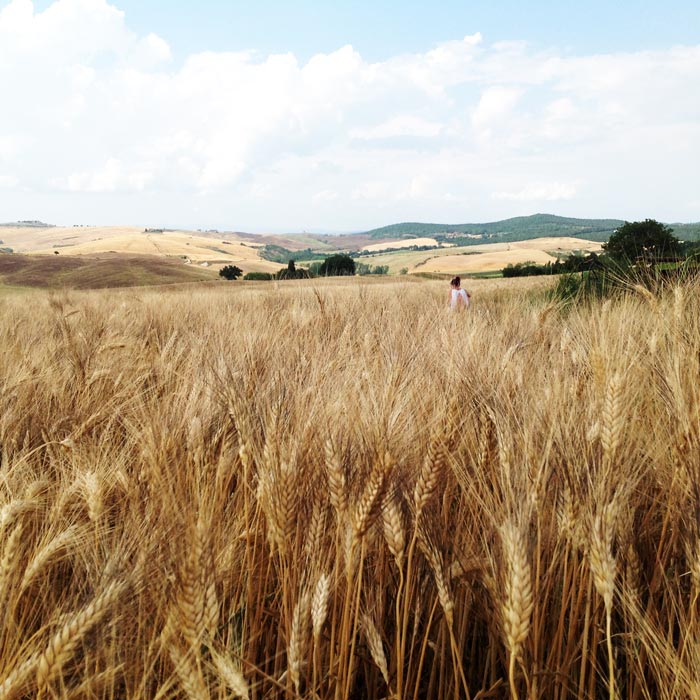Why painting the same chickadee?

- Confronted with the landscape, the artist needs to surrender to nature in order to truly express on canvas the unique emotions and feelings resulting from this challenge. Here, Zoe letting go in the Val d’Orcia during our painting workshop in Tuscany Studio Italia.
Recently I finished reading an excellent book about time by Carlo Rovelli, L’ordre du temps (Flammarion, 2018) also translated into English: The Order of Time. Well written, in a simple manner, the author was able to tame my artistic nature allowing me to enter one of the most complex questions of physics, the notion of time. I bought the book because as I get older, time seems to go faster and faster. After reading it, I have learned that time doesn’t exist. Time, as we know, is a mere human construct.
Maybe it is a coincidence, but last week I went to the screening of …and Suddenly the Dawn ( … Y de pronto el amanecer), a wonderful movie by Chilean director Silvio Caiozzi (the man in the image above). It is about an old writer, Pancho, returning to his hometown in Chilean Patagonia in order to find inspiration for his next short stories (seen here as a boy in image above). There, he is confronted by his own past, and he must rethink his life. I sat through the whole three hours and plus, as if time disappeared, and Rovelli’s came to my mind.
The notion of time as Rovelli’s defines it is well underlined in the film. On the one hand, often we see the movement of the clock, the endless mobile phone calls and the screen of the cellular phone; on the other hand, we saw the juxtaposition of Pancho’s memories, traces and emotions. Throughout his book, Rovelli invites us to understand that time per se doesn’t exist. This because among other reasons, the world, in the sense of what we perceive as reality, is composed of “events” and not “things”. In order to demonstrate his train of thought, the physicist uses the example of the stone and the kiss: a thing (a stone) lasts in time. If I put a stone on my desk, tomorrow I can check if it is still there. An event (a kiss) is a happening; it is the product of an interaction that is limited in space and time. Tomorrow I cannot look for a kiss that happened just now. Therefore, the world is made of networks of kisses, not stones. He also says that time is manifested not through the Tic Tac of a clock (in the movie), but by the entropic nature of the world, simply physical “changes”, such as the growth of animals and plants and the changes of the physical body (also in the movie).
My post is not to summarize Rovelli’s work, but to make a relationship between art and time, hence my question to Sylvio Caiozzi, the movie’s director who was present during the screening. After a needed preamble, I asked, “ … therefore, your movie is a succession of stories. Señor Caiozzi, what is time for you?” He was a bit cut short after so many questions that dealt with the logistic of the making of his film, but his answer reflected so much Rovelli’s book. He said more or less: “You saw the presence of a man-made time, the hands of the clock, the cellphone, but also I wanted to show time through the juxtaposition of Pancho’s physical and emotional changes. There are no flashbacks in the film; what we see is Pancho’s imaginative revival of emotional past events as he thinks and writes about them in the present moment”. And, slowly, introspectively, he kept answering the question in a highly philosophical manner. We could have discussed a bit more, but it was late, and the public was desperate to taste the empanadas and the Carmener offered by the Chilean embassy in Ottawa.
To conclude, if time is a juxtaposition of events, “a network of kisses”, the manifestation of the world in constant changes, why so many “artists” always paint the same subject, the same shapes; repeat the same colour schemes, the very same stories, the…? John Baldessari was tired of repeating, the reason he did the lithograph I Will Not Make Any More Boring Art (in the image above, with the chickadee).
Which comes back to my post on repetition. After 40 years, Pancho returned to his native Patagonia to confront his fears, his feelings, his old relationships, the network of events that shaped his identity. And he found many answers in the little village and the old friends whose aspirations had not changed much. This is a good lesson for us as artists searching to innovate, to break with old patterns, to make art that is more personal.
Ultimately, does the mystery of time belong to us, to whom we are? Are we Time?


Toujours un plaisir de te lire,
Tes pensées, ainsi que celles de Rovelli et de Caiozzi sur le temps, ce qu’on appelle le temps, m’ont interpellée. C’est un concept qui m’intrigue et auquel je réfléchis. Oui, on dirait qu’en vieillissant le «temps» passe plus vite. Et, d’une part, ce qui s’est passé hier semble être très loin derrière alors que, d’autre part, ce qui est arrivé il y a des mois ou des années semble très récent. À un certain moment, je ne sais pas trop quand, j’ai commencé à dire et à croire que ce n’est pas le temps qui passe, que c’est plutôt nous qui passons dedans… Notre vie se mesure-t-elle en pierres ou en baisers? Faut dire que j’aime bien cueillir, encore à mon âge, des pierres sur la plage. Et l’âge, qu’est-ce que c’est?…
Louise